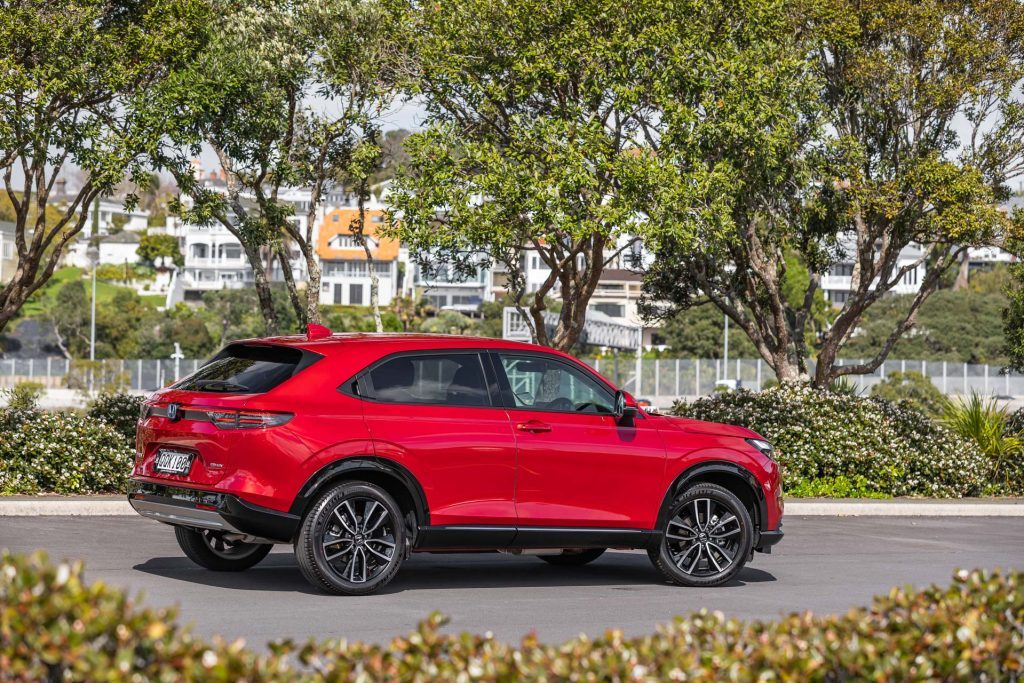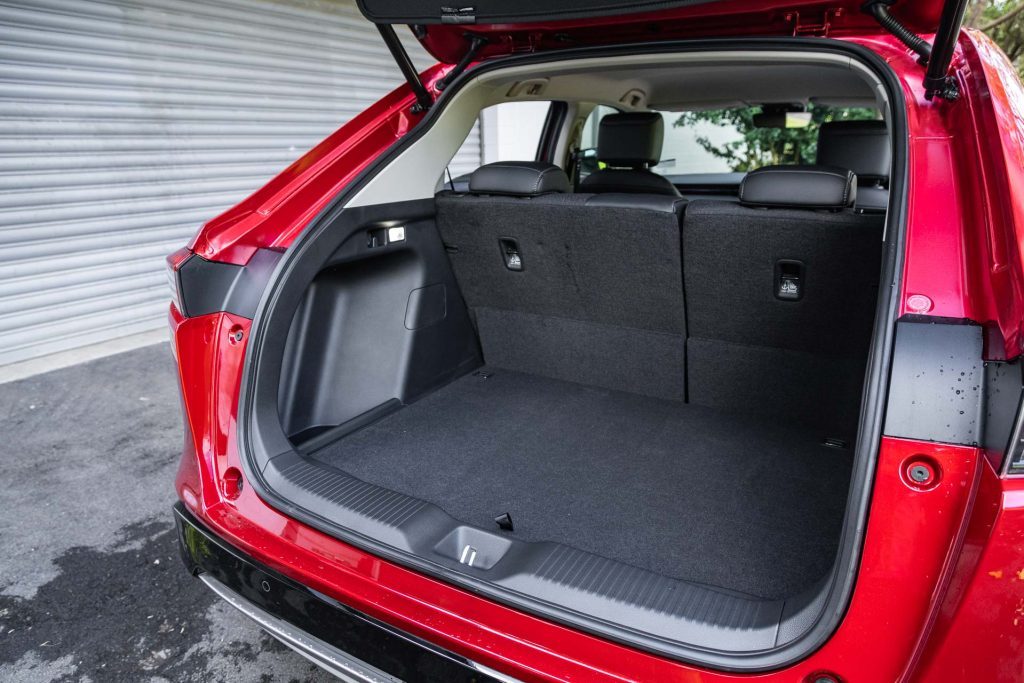HR-V, Honda’s compact SUV, first arrived in 1998. This latest model that’s just launched isn’t brand new per se; it’s the facelift of the third-generation 2021 model that Kiwis never got.
Never mind because it’s here now, and in hybrid guise only. It uses the same powertrain as the Jazz hybrid, and a version of its novel rear seating.

The latter still makes sense today, and is just as handy as when it arrived around the turn of the millennium. There are 18 different variations and it remains a magic luggage-toting solution.
For example, we rode our bike to Honda to pick up the HR-V. Open both rear doors – the releases are disguised up on the darkened C pillar to make this seem coupe-like – and then unfix the rear seat backs.
These flop down as the squabs move forward making a ruler flat load space. Blow up a mattress and you could sleep in there.
The cargo cover cleverly attaches to the rear door, which is power operated, so you don’t need to remove that to get the bike in. Brilliant.

You do need to remove the front wheel – of the bike that is – and it comfortably slides in, hatch down, job done.
At the media launch we got to drive HR-V only on country roads and highways. That highlighted the fun driving dynamics and the pliant ride, a nicely judged mix of the two.
But we also saw HR-V’s fuel economy at its worst. For example, on the 110km/h Expressway petrol consumption plateaued at 7.3L/100km.
However, that’s way better than the second-gen HR-V we also drove on the launch which hit double figures. Back on regular state highways and back roads we saw fuel use in the latest version average high fives.

But it is capable of much better than this. For example, between Newmarket Honda pick-up and home in Ponsonby, the HR-V was in ‘EV’ engine-off mode roughly one-third of the time.
Which is a pretty good trick for a vehicle with a 1kWh battery. And that’s been my experience ever since. If you’re careful it’s certainly possible to see average fuel use figures in the high threes when patrolling urban streets.
We figured at the launch it ought to be possible to meet the 4.3L/100km combined figure.
However, it’s easy enough to achieve even better figures in town. Not bad then for a reasonably sized compact SUV.

Honda’s dual-motor hybrid system features a drive motor, a generator and a four-pot 1.5L Atkinson cycle engine that creates 78kW and 127Nm.
Not much output, sure, but then its primary job is to run the generator which keeps the battery charged. The traction motor produces 96kW and 253Nm and is the main motivator of the HR-V.
The 1.5 only ever drives the wheels at motorway cruising speeds. During any braking or downhill work you can optimise regen using the paddles or by flicking the gear lever into the B mode (effectively the top regen setting).

Generally the engine will switch off on downhill running unless the battery level is kaput. But the small lithium unit doesn’t take long to reconstitute.
We had a wee job to do across town and once again, fuel use was reading in the high threes, so that’s about half as much fuel as it uses on the open road under cruise control. It sips 91 octane too.
The gear we had fitted comfortably in the rear seat footwell once I had advanced the passenger seat forward. You’d not credit the amount of knee room in the rear.
This HR-V is marginally longer at 4345mm than the second-generation but all of the extra seems to have ended up as added leg space.
There’s not only generous knee room with the front seats set midway forwards/back but also ample footroom because the front seats are raised slightly in the new model.

Just bear in mind there’s only seating and belts for two in the rear. With the coupe-like roof the headroom isn’t quite as generous as knee and foot clearance either but it’s fine for regular adults.
If these aren’t in use, you might clip the squabs up against the rear seat backrests and employ the resulting space for taller items, like a kid’s bike. There’s surprising space in there so configured.
Likewise in the luggage bay where there’s also a handy underfloor storage area for things you’d rather not lose should someone break into your car.
As for the boot space itself, there’s 335L, expanding to just under 1000L after split folding. There’s no space for a spare.

In a sea of electric vehicles that have a host of controls ceded to the central touch screen, this is a bit different. The smallish central touchscreen is primarily there for infotainment purposes.
Bluetoothing your phone is simple, and so is saving favourite radio stations which takes no time. The rest of the controls are within the main instruments, which is where you might turn off lane keeping if you so choose.
And in terms of trip info, the only things you might want to swap between are average fuel use, state of battery charge and energy flow, though the latter you don’t bother with much given the only way to influence things is to increase regeneration on downhill runs using the paddles.

Use the B mode lever position for setting speed into bends. As mentioned in the initial launch drive, it’s not like a one-pedal drive system but sometimes these can be a bit OTT. The four levels of regen feel about right to me.
Not only is the HR-V intuitive to drive but it’s also clean and simple, outside and in as it happens. We like the use of gloss paint for the wheel arch surrounds and body paint in the grille.
Climb aboard and you sit up quite high in this, though you soon forget about that. Visibility is simply outstanding, though it does pay to keep an eye on the overhead camera shot when reversing.
With a smaller screen, you need to peer a little harder than with the monster screens others have nowadays.

Controls are pretty simple though. Entry and exit are keyless, just pull the handle to unlock, push on the appropriate part of the external door pull to lock.
There’s a power on/off switch up high and not hidden by the wheel rim. Push that, buckle up, select D and away you go. The turning circle is okay without being special at 11m.
This has three drive modes, selectable down by the gear lever. But, as is often the case, you’ll use Normal normally. Eco feels a bit tame. HR-V is oriented towards economy so isn’t all that quick, taking around 10sec to accelerate to 100km/h from stopped.

And you’d not go for the hero overtake in this because it just won’t happen; it takes about 8sec to get from 80 to 120km/h.
If you want a bit more firepower, an extra seating spot in the rear and don’t care so much about economy, you should check out the base ZR-V Turbo at $47k, as it is not much more expensive than the HR-V Sport at $45,800. HR-V now costs about $6k more than the old model, but this is better specified.
Standard features include adaptive cruise with stop and go, smartphone integration, sat nav, dual zone air with a novel air dispersion system, heated seats and steering wheel, a powered tailgate that self-closes as you walk away and the full Honda Sensing safety suite.

Figure on a top-down camera, HDC, RCTA, BSM, AEB, and LKA, amongst other acronyms.
HR-V can be had in five colours and has a three-year/unlimited km warranty (eight years for the battery). The regular cover extends by two years if servicing is done by the book at an authorised Honda outlet.
| Model | Honda HR-V Sport |
| Price | $45,800 |
| Engine | 1497cc, IL4, EFI |
| Power | 78kW @ 6000-6400rpm |
| Torque | 127Nm @ 4500-5000rpm |
| Motor Output | 96kW / 253Nm |
| Drivetrain | e-CVT, FWD |
| Turning circle | 11.0m (2.6 turns) |
| Fuel Use | 4.3L/100km |
| C02 Output | 98g/km |
| 0-100km/h | 9.98 sec |
| Tyre Size | f/r-225/50/R18 |
| Fuel Capacity | 40L |
| Stability systems | ABS, ESP |
| Safety | AEB, ACC, BSM, LDW, RCTA, ALK, AHB |
| Luggage Capacity | 335-987L |
| Tow rating | Not rated to tow |
| Service intervals | 24 months/30,000km |
| Warranty | 3-5 years/unlimited km |
| ANCAP rating | 4 Stars (2022) |
| Weight | 1382kg (claimed) |
This article first appeared in the October 2024 issue of NZ Autocar Magazine.


